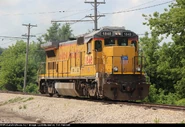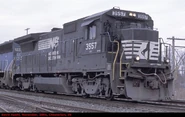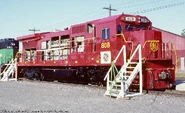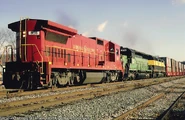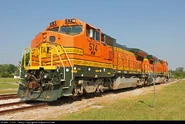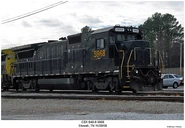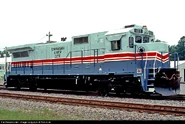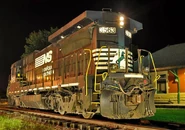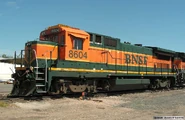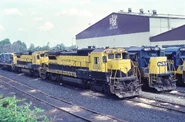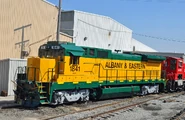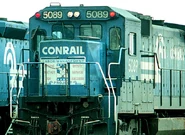Bio[]
The GE (General Electric) B40-8 (B40-8B, Dash 8-40B, or simply "Dash 8")
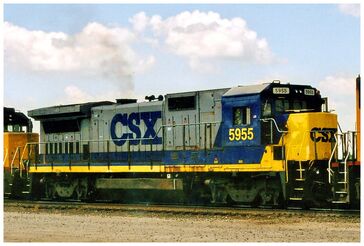
A CSX (ex Conrail) B40-8 (now classified as a "B20-8").
is a type of four-axle, 4,000hp diesel-electric locomotive built from 1988 to 1991 with 150 built (including 83 wide-cab units, totaling . It is essentially the four-axle version of the C40-8, yet it uses a different alternator to supply power to its 7FDL-16 engine as utilized on its counter-part. Many have since been retired and scrapped. Most notably CSX #5947, which was involved in two wrecks; despite being salvagable after the first one.
Many still exist, yet are often rare due to many having since been retired and scrapped from most original owners (with the exception of one that has been preserved). Although they have become gradually less popular and favorable with Class 1 railroads over the years, they have since found use on various regionals and shortlines (some have also been de-rated from 2,000 to 3,900hp, however).
Southern Pacific (including Cotton Belt), Conrail (CR), ATSF (Santa Fe), the Savannah River Site (SROX; Savannah River Operations), and the NYSW (New York And Susquehanna Railway) were among the original customers to purchase the model. Later owners consist of CSX, NS (Norfolk Southern), and the Providence And Worcester shortline (P&W) among many others.
It is the successor to the B39-8: its lesser-known and less-popular counter-part. Many B39-8 units have since been reclassed and re-rated to 4,000hp B40-8's and vice-versa, however.
CSX, UP, and BNSF were the largest owners between 1996-2014. Since 2014, UP has retired the entirety of their ex-SSW B40-8 (and subsequent SSW B39-8) fleet, while CSX recently made the decision to retire all of their standard-cab Dash 8 units, which included their ex-NYSW and ex-Conrail B40-8 (and subsequent de-rated B20-8 units) off of their roster in late 2016. Said units have been acquired by numerous shortlines like the Nashville and Eastern (NERR), which has had an increasing favorability with second-hand GE locomotives.
As of 2017, BNSF is currently the sole Class 1 railroad to utilize four-axle GE units of any known model, including the B40-8.
History[]
The B40-8 was one of the last major production models of four-axle diesel locomotives produced by GE (not counting their "Super 7" rebuild models), had the highest nomial amount of horsepower rating on any four-axle diesel locomotive produced for the North American locomotive market, and furthermore featured a wide-cab variant built exclusively to the ATSF in response to the EMD GP60M. Although originally intended for high-speed intermodal service, it also served as an initial replacement for the majority of preceding Dash 7 and Universal Series four-axle models in active service owned by railroads at the time (despite most Dash 7 units having less than 10-15 years of service at the time). Another target for GE, was replacing most; or just about all, of their rival's GP (General Purpose) series of diesels utilized for mainline and road switching services; aside from rivaling the 3,800hp GP60 for said intended purpose. Yet the initial plans, however, failed as a result of the model's lack of popularity and short-term basic warranties: being used as "conventional power" like most GE diesels,
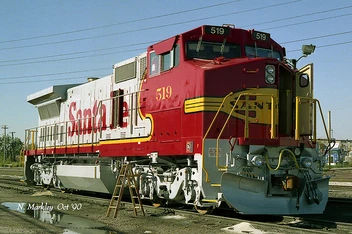
Brand new ATSF B40-8W #519 when it was first delivered sometime in 1991 (photo date inaccurate).
and the fact that the model served as a last-ditch effort to cash-in on the four-axle market since most railroads were in the process of phasing out four-axle locomotives in favor of six-axle models (including its six-axle counter-part) being the preferred choice for horsepower. Hence, the B40-8 became part of the secondary locomotive market with only 150 produced of the stock model, with such units eventually finding use working alongside existing fleets of earlier or preceding four-axle road switchers (such as GP40-2's); serving as heavy-duty switchers for yard and local service as opposed to tending to mainline traffic like their initial intented purpose upon debut. Though, customers such as the Southern Pacific, NYSW, and Conrail utilized their fleets of B40-8 units (with the exception of SP's subsequent B39-8 units) for high-speed intermodal service. Yet their successors (UP, CSX, and NS) de-rated, downgraded, and reassigned such units in which they acquired and inherited after their respectful mergers from 1996-1999.
Its six-axle counter-part, the C40-8, drastically surpassed the B40-8 in rapid sales, production, and popularity, and served as a monumental piece of North American locomotive history by evolving into its successors, which furthermore surpassed the Dash 8 line as a whole in terms of sales: being the Dash 9, AC, and Evolution Series diesel locomotive lines; all which were developed in-part due to the C40-8's commercial success.
B40-8W[]
A wide-cab version, the B40-8W (B40-8BW, or Dash 8-40BW), was produced exclusively for the Santa Fe in 1991 with only 83 built. Although initially slated to begin production two years earlier, the increasing popularity and demand with six-axle models being preferred on Class 1 railroads forced the B40-8W's debut to become side-lined, and furthermore debuted long after the increasingly-successful C40-8W entered production in 1989. Furthermore, the B40-8W was built specially for the ATSF upon request rather than gaining a full entry into GE's catalog due to poor sales and low demand. Like its six-axle cousin, the wide-cab prototype (GECX #809; originally a B39-8 demonstrator or testbed); having been built around late-1988, initially served as the basis or mechanical testbed for GE's "wide-cab" or North American Safety Cab design (having been derived of the Canadian Safety Cab or "Canadian Cab"), furthermore leading towards the final cab design for the C40-8W model after numerous tests and evaluations were conducted. The final cab design can seen on GE's Dash 9 and subsequent models built post 1993, and is now a common sight on today's major modern railroads.
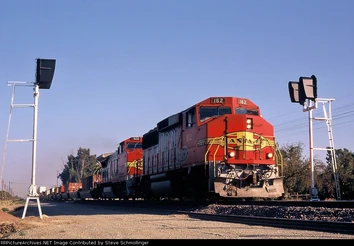
An ATSF B40-8W trailing behind a GP60M: its initial rival, leading a loaded intermodal train out of Southern California past a pair of new CTC signals.
Said units were numbered in the ATSF's 500 series, and were some of the last entirely new four-axle road diesels built by GE. After the BNSF merger in 1996, they have since found life serving local and yard service. Some, however, have been leased and/or sold to various shortlines such as the Providence and Worcester (P&W). Some still even retain their former "Heritage 2" (H2) and "Warbonnet" schemes, only patched with unique decals and lettering in the former font. Such owners as the Nashville And Eastern (NERR) and the Arkansas And Oklahoma (AOK) own said units and are painted in such manner. The NERR has also dedicated their B40-8W units to the various cities serviced throughout the company's system.
The ATSF's earlier B40-8W units rode on 42-inch wheels as opposed to the usual 40-inch ones, and were also rated at 3,800hp as opposed to 4,000hp as originally designated. These moves were made upon special request from the railroad. The second batch of B40-8W units (ATSF 560-582); however, were built and delivered with a unique notched cab (referred to as a "gull wing" cab) and shorter wheelbase to meet clearance restrictions at the coal loadout facility in York Canyon, NM along the railroad's once-prosperous Raton Pass line. Said cab roof design was also utilized on every C40-8W and C44-9W built for the railroad. Ironically, after the BNSF merger, said roof design was still included during the delivery of every Dash 9 unit built between 1997-2004.
Remarkably, the GE wide-cab prototype (GECX #809) still exists, and remains part of GE's test fleet. The B40-8W testbed, however, originally began life as GECX #606: the sole B36-8, which was the very first Dash 8 unit ever built, and has undergone numerous major modifications since it was first constructed in 1983. Although bearing a resemblance to the final production model, GECX #809 is often classed as a "B39-8" or "B39-8E" rather than a "B40-8W".
Versions And Similar Models[]
B32-8 - 12-cylinder model similar to the B36-8 and B39-8. Was once classified as being part of the original "Super 7" Series testbed project during the early stages of development for the Dash 8 line (only three were built and were loaned and demonstrated to the BN). One was scrapped, while the remainder are still intact at GE's Erie facility.
B32-8E - "Enhanced" 3,150hp or 3,200hp 12-cylinder production model of the B32-8 built exclusively for NS, and often rated at a lower nomial horsepower rating (similar to their exclusive C40-9 and early ES40DC models) 45 built, one retired. Like the B30-7A, the 7FDL-12 was capable of producing the same amount of horsepower as the earlier 7FDL-16 engines equipped with the GTA Series alternators, but the advantage of having the GMG186 alternator meant the 12-cylinder engine could produce at least 3,800 to 3,900hp as its GMG196-equipped 16-cylinder counter-part.
B20-8 - Downgraded 2,000hp version from CSX with modified engine block intended to increase the longevity (life) of the locomotives as a result of maintenence costs and warranty issues.
P32-8BWH (or B32-8BWH) - Wide-cab passenger version of the B32-8E or B40-8W built exclusively for Amtrak; 20 units were built as compensation for the delayed unveiling of the "Genesis" design by Krupp and GE (though, both types/models in-turn were meant to serve as an initial replacement for the EMD F40PH).
B39-8 - 3,900hp predecessor of the B40-8; originally a completely different model, but became the class name for reclassified units (see below)
B39-8E - "Enhanced" production version of the original B39-8 with upgraded controls and numerous enhancements and/or improvements (though, the model name also serves as a designation for reclassified/reclassed B40-8 units per various railroad's rostering systems).
B40-8W - Wide-cab version of the B40-8; as listed above.
B36-8 - Experimental prototype (GECX #606). Only one was built, and became GECX #809: the B40-8W prototype (or simply the wide-cab B39-8 test unit).
Note: The "E" was initially used earlier in production as a way of differentiating between the testbeds and production models, while further avoiding confusion between the Super 7 rebuilds and testbeds of similar names.
Note: Some of Union Pacific's fleet of former SP B40-8 units are actually converted from B39-8's.
Specifications[]
| Model | B40-8 | B40-8W |
|---|---|---|
| Production Dates | 1988-1989 | 1990-1991 |
| Total Built | 151 | 83 |
| Length | 66' 4" | 66' 4" |
| Wheel Arrangement | B-B | B-B |
| Engine | 7FDL-16 | 7FDL-16 |
| Horsepower Rating | 4,000 | 4,000 |
| Alternator | GMG186 | GMG186 |
| Traction Motors | 752AG | 752AG |
| Weight x 1,000 lbs. | 288 | 289 |
Production Roster[]
| Owner | Quantity | Road Numbers | Disposition |
|---|---|---|---|
| ATSF (Santa Fe) | 40 | 7410-7449 | Most in active service with BNSF; some scrapped, sold, or stored as parts donors for active units. |
| Conrail (CR) | 30 | 5060-5089 | Most in service with CSX. Some scrapped. |
| General Electric Company Leasing (GECX) | 1 | 8002 | Sitting in storage at UP's Englewood Yard in Houston, TX (now BCOL 3903). |
| New York, Susquehanna and Western Railway (NYSW) | 24 | 4002-4048 (even nos.) | Most in service with CSX; 4 sold to P&W. |
| St. Louis And Southwestern (SSW) | 54 | 8040-8093 | One donated to a museum, the remainder stored and retired. Few have been sold to numerous shortlines or industrial companies. |
| United States Department of Energy (SROX) | 1 | 107 | Still in service as of 2013. |
Spotting Differences[]
Although vaguely similar, the differences between the B40-8, B39-8, and subsequent B32-8E are very subtle, yet either model should not be confused for one another.
- The B32-8E is slightly shorter in length compared to the latter, and has six power-assembly access doors or access panels located on the center of the carbody or center hood, thereby indicating the presence of a 12-cylinder engine.
- Most B39-8 units have greater spacing or large gaps in between the trucks and the fuel tank unlike most B40-8's.
- The owner, number series, and designation often are other ways of distinguishing the latter.
- NS (minus one exception; see below) is currently the only owner of the B32-8E.
Trivia/Facts[]
The GE Genesis Series was originally considered to be part of GE's Dash 8 line, while the original P40DC (AMD-103) is practically a modified B40-8 because of how similar their components and technology are (aside from the latter being rated at 4,000hp). Yet, the GE Genesis line (obviously) developed into its own independent or individual locomotive line seperate from the Dash 8 line; being a passenger locomotive line.
B40-8's have also been nicknamed "B Boats" by railfans reminiscent of preceding Dash 7 models like the B23-7.
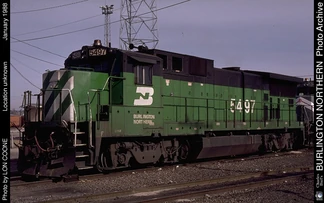
One of the three BN (Burlington Northern) B32-8 prototype demonstrator/testbed units which inspired the development for the B39-8 and B40-8.
GECX #808 (originally B36-7 #606) was the original B40-8 testbed unit (built in late-1986), which also served as a demonstrator until around 1989. The unit practically began production immediately after its success demonstrating on CSX, Conrail, and other respective owner's systems (customers which later grew interested in owning the model) during the course of a three year demonstration run alongside various other GE models owned by said railroads as well.
NS originally acquired a fleet of former Conrail B40-8 units after the 1999 split, yet they soon sold 18 of said units to CSX around 2006 due to the fact that they weren't necessarily needed, and the railroad preferred the use of their older EMD diesels for yard and/or local service. Though, CSX used the remainder of units until 2009, when most were placed in storage due to the "Great Recession" of 2008. But as of early 2012, their ex-Conrail B40-8's have since officially re-entered service with the railroad; despite several downgrades, therefore transforming them into "B20-8's".
CSX's current B40-8 fleet also consists of former NYSW B40-8's in which they acquired prior to their ex-Conrail units. Since the split in 1999 and the trade with NS in 2006, their B40-8 fleet has since grown to be larger than what it originally was before the Conrail split (with CSX only having 20 of the ex-NYSW units originally). 4 of the NYSW B40-8 units were also sold to the P&W in 2005.
Conrail's first fleet of B40-8 units had special banners applied to the front hoods to promote their high-speed intermodal service.
In mid-2013, NS has been in the process of renumbering, retiring, and auctioning off their 3522-3566 series of B32-8E units (with #3563 being the first of the fleet) in favor of rebuilding used ex-BN SD40-2's to utilize for yard and/or local service. During that time, Norfolk Southern donated NS #3563 to the Lake Shore Railway Historical Society where it now currently resides as being the very first Dash 8 unit ever preserved to a museum; despite the unit itself being less than 20 years old as opposed to the usual preserved types and models of locomotives ranging from being more than 30+ years old. Although the unit suffered major engine and other mechanical issues, NS overhauled the unit before donation, and (supposedly) reconverted it back to having 4,000hp as opposed to having a modified engine block resulting in 3,200hp (replacing the 12-cylinder engine in favor of a 16-cylinder one).
During July 2014, UP donated one of their own former SSW B40-8 units; #1848, to the Illinois Railway Museum (IRM), making it the second Dash 8 ever preserved (despite being no more than 25 years old). Although the unit is in fairly decent shape, it unfortunately is currently suffering radiator issues with its cooling system.
NYSW's numbering system wasn't in sequential order for their B40-8 fleet. Rather, each unit was given an even number beginning with 4002-4048. Though, as per tradition for the railroad, certain locomotive classes were given even numbers, while others received odd numbers.
Both the SP's B39-8 and subsequent SSW B40-8 fleets were equipped with Nathan K5H and/or K5HR24 airhorns as opposed to the more common or usual Nathan P3 and P5 horns utilized by the railroad.
Gallery[]
Sources[]
http://www.rrpicturearchives.net/locolist.aspx?id=CSX&mid=93 (CSX B40-8 roster)
http://www.flickr.com/photos/108491399@N08/14295856897 (Unique photo)
http://www.rrpicturearchives.net/locopicture.aspx?id=14350 (NS 4809)
https://www.amazon.com/Locomotives-Modern-Diesel-Electric-Reference/dp/1554078962
http://thedieselshop.us/CSX.HTML
http://1stclass.mylargescale.com/Scottychaos/susquehanna/
http://www.thedieselshop.us/BNSF.HTML
http://www.thedieselshop.us/UP.HTML
http://www.pwrfc.net/roster.html
Videos[]

UP 1848, a GE B40-8 at IRM tour, walkaround, and more!
UP #1848 at the IRM.

CSX B40-8 Startup!
A CSX B40-8 starting up (courtesy of SpeakerPolice).

